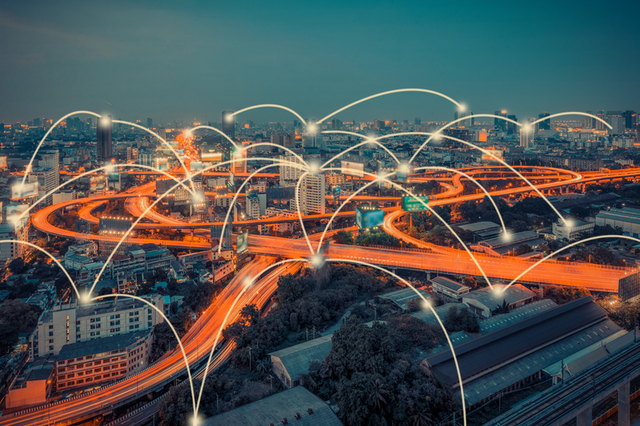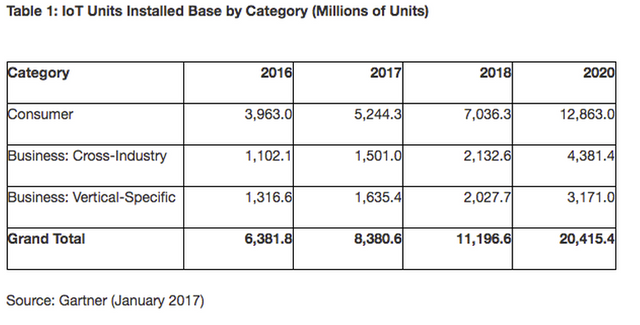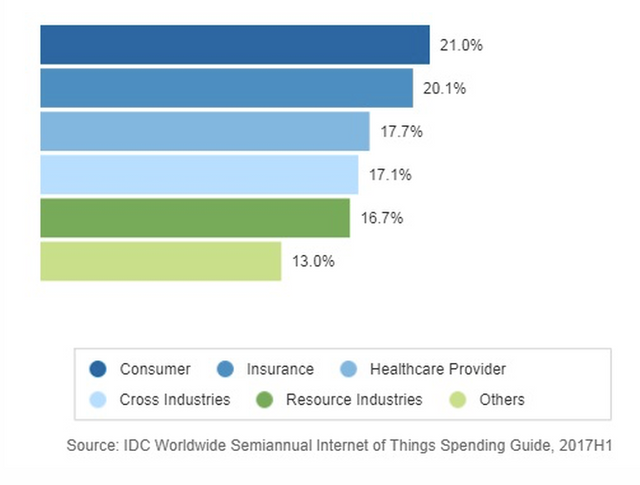The Internet of Things, or IoT, refers to billions of physical devices around the world that are now connected to the internet, collecting and sharing data. Thanks to cheap processors and wireless networks, it's possible to turn anything, from a pill to an aeroplane, into part of the IoT. This adds a level of digital intelligence to devices that would be otherwise dumb, enabling them to communicate without a human being involved, and merging the digital and physical worlds.
EXAMPLES OF IOTs
Pretty much any physical object can be transformed into an IoT device if it can be connected to the internet and controlled that way.
A lightbulb that can be switched on using a smartphone app is an IoT device, as is a motion sensor or a smart thermostat in your office or a connected streetlight. An IoT device could be as fluffy as a child's toy or as serious as a driverless truck, or as complicated as a jet engine that's now filled with thousands of sensors collecting and transmitting data. At an even bigger scale, smart cities projects are filling entire regions with sensors to help us understand and control the environment.
The term 'IoT' is mainly used for devices that wouldn't usually be generally expected to have an internet connection, that can communicate with the network independently of human action. For this reason, a PC isn't generally considered an IoT device and neither is a smartphone -- even though the latter is crammed with sensors. A smartwatch or a fitness band might be counted as an IoT device, however.
Big and getting bigger -- there are already more connected things than people in the world. Analyst Gartner calculates that around 8.4 billion IoT devices were in use in 2017, up 31 percent from 2016, and this will likely reach 20.4 billion by 2020. Total spending on IoT endpoints and services will reach almost $2tn in 2017, with two-thirds of those devices found in China, North America and Western Europe, said Gartner.
Out of that 8.4 billion devices, more than half will be consumer products like smart TVs and smart speakers. The most-used enterprise IoT devices will be smart electric meters and commercial security cameras, according to Gartner.
Internet of Things IoT Gartner

HOW BIG IS THE IOTS ?
Big and getting bigger -- there are already more connected things than people in the world. Analyst Gartner calculates that around 8.4 billion IoT devices were in use in 2017, up 31 percent from 2016, and this will likely reach 20.4 billion by 2020. Total spending on IoT endpoints and services will reach almost $2tn in 2017, with two-thirds of those devices found in China, North America and Western Europe, said Gartner.
Out of that 8.4 billion devices, more than half will be consumer products like smart TVs and smart speakers. The most-used enterprise IoT devices will be smart electric meters and commercial security cameras, according to Gartner.

Another analyst, IDC, puts worldwide spending on IoT at $772.5bn in 2018 -- up nearly 15 percent on the $674bn that will be spent in 2017. IDC predicts that total spending will hit $1tn in 2020 and $1.1tn in 2021.
According to IDC, hardware will be the largest technology category in 2018 with $239bn going on modules and sensors, with some spending on infrastructure and security. Services will be the second largest technology category, followed by software and connectivity.
BENEFITS OF IOTs
Occasionally known as the Industrial Internet of Things (IIoT), the benefits of the IoT for business depend on the particular implementation, but the key is that enterprises should have access to more data about their own products and their own internal systems, and a greater ability to make changes as a result.Manufacturers are adding sensors to the components of their products so that they can transmit back data about how they are performing. This can help companies spot when a component is likely to fail and to swap it out before it causes damage. Companies can also use the data generated by these sensors to make their systems and their supply chains more efficient, because they will have much more accurate data about what's really going on.
"With the introduction of comprehensive, real-time data collection and analysis, production systems can become dramatically more responsive," say consultants McKinsey.
Enterprise use of the IoT can be divided into two segments: industry-specific offerings like sensors in a generating plant or real-time location devices for healthcare; and IoT devices that can be used in all industries, like smart air conditioning or security systems.
While industry-specific products will make the early running, by 2020 Gartner predicts that cross-industry devices will reach 4.4 billion units, while vertical-specific devices will amount to 3.2 billion units. Consumers purchase more devices, but businesses spend more: the analyst group said that while consumer spending on IoT devices was around $725bn last year, businesses spending on IoT hit $964bn. By 2020, business and consumer spending on IoT hardware will hit nearly $3tn.
So guys please write your views on IOTs in comment box...
thankyou...
✅ @amanchandra, I gave you an upvote on your post! Please give me a follow and I will give you a follow in return and possible future votes!
Thank you in advance!
Downvoting a post can decrease pending rewards and make it less visible. Common reasons:
Submit
Ok
Downvoting a post can decrease pending rewards and make it less visible. Common reasons:
Submit
Hi! I am a robot. I just upvoted you! I found similar content that readers might be interested in:
https://www.zdnet.com/article/what-is-the-internet-of-things-everything-you-need-to-know-about-the-iot-right-now/
Downvoting a post can decrease pending rewards and make it less visible. Common reasons:
Submit